
The Boboli Gardens, or Giardino di Boboli, is a beloved gem nestled in the heart of Florence, Italy. Famous for its captivating marriage of art, history, and nature, this park is more than a mere garden – it’s a living museum. As of 2025, the entrance fee for the Boboli Gardens is 10 Euros.
The working hours of Boboli Gardens are quite distinctive. They open their gates every day at 8:15 am. However, the closing time varies depending on the month of the year. In January, February, November, and December, the gardens close at 4:30 pm. In March (Standard Time) and October, visitors can stay until 5:30 pm, but the closing time extends to 6:30 pm during March with Daylight Savings Time, April, May, September, and October with Daylight Savings Time. During the peak of summer from June to August, visitors can wander until as late as 7:10 pm.
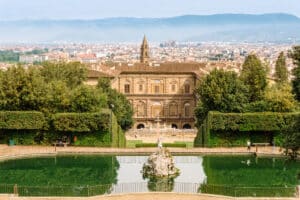
Boboli Gardens
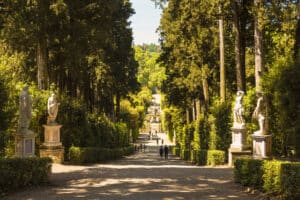
Boboli Gardens
Historical Overview
Born from the Medici family’s imagination in the 16th century, the Boboli Gardens have been a spectacular showcase of Italian Renaissance culture. They evolved gradually over centuries, with each ruling family leaving its distinctive mark.
At its core, the Boboli Gardens embody the quintessential spirit of the Renaissance – a harmonious blend of art, science, and the natural world. It’s a meticulously crafted open-air museum, a testament to the grandeur of its era.
Over the years, the Boboli Gardens have witnessed many significant events – from grand Medici celebrations to fierce political debates during the Italian Risorgimento. They’re not just gardens, but a witness to Florence’s tumultuous past.
Architectural Highlights
- Amphitheatre: As you wander the paths, the grand Amphitheatre emerges – a testament to the Medici’s love for theatre. Here, stone steps rise towards the sky, providing a dramatic setting for performances in the past.
- Neptune’s Fountain: Further along, you encounter Neptune’s Fountain. The mighty god of the sea, carved from white marble, stands imposingly in the centre of a basin, reminding visitors of Florence’s historical connection with water.
- The Island Pond: The Island Pond, or Isolotto, is another must-see. It’s a haven of tranquillity, with its large pond, sculptures, and verdant vegetation, providing a peaceful respite in the midst of the city’s hustle and bustle.
Flora and Fauna
- Botanical Variety: The Boboli Gardens hosts a diverse range of plant species, from ancient cypresses to various fruit trees. Every turn reveals new botanical treasures.
- Native Species: Among the lush greenery, native Italian species thrive, creating an authentic Tuscan landscape. The gardens’ commitment to maintaining native flora speaks to its historical fidelity.
- Seasonal Highlights: Each season brings new delights. Whether it’s the vibrant blossoms of spring or the russet hues of autumn, there’s always something to marvel at in the Boboli Gardens.
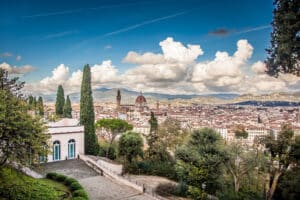
Florence from Boboli Gardens
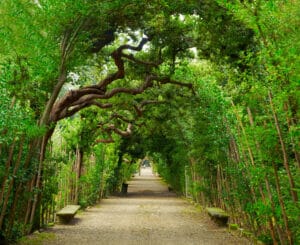
Boboli Gardens
Art in the Boboli Gardens
- Sculptures: The gardens are adorned with sculptures ranging from the Roman era to the 17th century. Each work adds a layer of historical and artistic depth.
- Statues: Imposing statues dot the landscape, each telling a story. From classical Roman figures to whimsical creations, they lend an otherworldly aura to the surroundings.
- Ancient Artefacts: Tucked away are ancient artefacts and relics, offering glimpses into a distant past. They are a testament to the rich tapestry of culture and history the gardens embody.
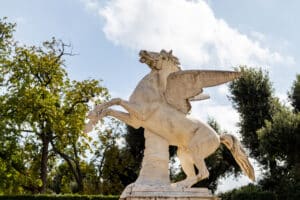
Boboli Gardens
What to Expect
- Walking Tours: Guided walking tours provide insights into the gardens’ history and secrets. Alternatively, you can explore at your leisure, discovering its charms at your own pace.
- Museums: The gardens house several museums, including the Porcelain Museum and the Costume Gallery. Each provides a different perspective of Italian history and culture.
- Photo Opportunities: Every corner of the Boboli Gardens offers exquisite photo opportunities, from panoramic views atop the garden’s hills to the close-up details of statues and flora.
Nearby Attractions
- Pitti Palace: The grand Pitti Palace, once home to the Medici family, is a stone’s throw away. It’s an architectural marvel with its own trove of art and history.
- Ponte Vecchio: The Ponte Vecchio, Florence’s oldest bridge, is another nearby attraction. Its shops and stunning Arno River views make it a must-visit.
- Uffizi Gallery: Not far off is the Uffizi Gallery, home to some of the world’s most treasured art masterpieces. A visit to the gallery complements the artistic journey of the Boboli Gardens.

